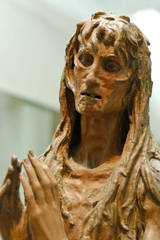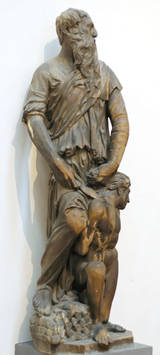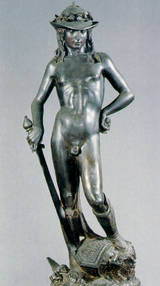DONATELLO (diminutive of Donato) (c. 1386-1466), Italian sculptor, was the son of Niccolo di Betto Bardi, a member of the Florentine Wool Combers’ Guild, and was born in Florence probably in 1386. The date is conjectural, since the scanty contemporary records of Donatello’s life are contradictory, the earliest documentary reference to the master bearing the date 1406, when a payment is made to him as an independent sculptor.
That Donatello was educated in the house of the Martelli family, as stated by Vasari, and that he owed to them his introduction to his future friend and patron, Cosimo de’ Medici, is very doubtful, in view of the fact that his father had espoused the cause of the Albizzi against the Medici, and was in consequence banished from Florence, where his property was confiscated.
It is, however, certain that Donatello received his first training, according to the custom of the period, in a goldsmith’s workshop, and that he worked for a short time in Ghiberti’s studio. He was too young to enter the competition for the baptistery gates in 1402, from which Ghiberti issued victorious against Brunelleschi, Jacopo, della Quercia, Niccolo d’Arezzo and other rivals. But when Brunelleschi in his disappointment left Florence and went to Rome to study the remains of classic art he was accompanied by young Donatello.

Whilst pursuing their studies and excavations on classic soil, which made them talked about amongst the Romans of the day as “treasure seekers,” the two young men made a living by working at the goldsmiths’ shops.
This Roman sojourn was decisive for the entire development of Italian art in the 15th century, for it was during this period that Brunelleschi undertook his measurements of the Pantheon dome and of other Roman buildings, which enabled him to construct the noble cupola of S. Maria del Fiore in Florence, while Donatello acquired his knowledge of classic forms and ornamentation.
The two masters, each in his own sphere, were to become the leading spirits in the art movement of the 15th century. Brunelleschi’s buildings and Donatello’s monuments are the supreme expression of the spirit of the early Renaissance in architecture and sculpture and exercised a potent influence upon the painters of that age.
Donatello probably did not return to Florence before 1405, since the earliest works in that city that can be traced to his chisel are two small statues of “prophets” for the north door of the cathedral, for which he received payment in November 1406 and in the beginning of 1408. In the latter year he was entrusted with the important commissions for the marble “David,” now at the Bargello, and for the colossal seated figure of ” St John the Evangelist,” which until 1588 occupied a niche of the old cathedral facade, and is now placed in a dark chapel of the Duomo.
We find him next employed at Or San Michele, where between 1340 and 1406 only four of the fourteen niches had been filled. As the result of a reminder sent by the Signory to the g ilds who had undertaken to furnish the statues, the services of Ciuffagni,Nanni di Banco, Ghiberti and Donatello were enlisted, and Donatello completed between 1412 and 1415 the “St Peter,” the “St George” (the original, now in the Bargello, has been replaced by a copy) and the “St Mark.”
He probably also assisted Nanni di Banco in his group of four saints. To this early period – in spite of Dr Bode’s contention, who places it about twenty years later – belongs the wooden crucifix in S. Croce, the most striking instance of Donatello’s realism in rendering the human form and his first attempt at carving the nude.
It is said that this crucifix was executed in rivalry with Brunelleschi’s noble work at S. Maria Novella, and that Donatello, at the sight of his friend’s work, exclaimed, ” It has been left to you to shape a real Christ, whilst I have made a peasant.” In this early group of statues, from the prophets for the cathedral door to the ” St George,” can be followed the gradual advance from Gothic stiffness of attitude and draping to a forceful rendering of the human form and of movement, which is a distinct approach to the classic ideal; from the massiveness of the heavily draped figure to easy poise and muscular litheness.
All these figures were carved in marble and are admirably conceived in relation to their architectural setting. In fact, so strong is this tendency that the “St Mark,” when inspected at the master’s workshop, was disapproved of by the heads of the Gild of Linen-weavers, but aroused public enthusiasm when placed in situ, and at a later date received Michelangelo’s unstinted admiration.
 Between the completion of the niches for Orsanmichele and his second journey to Rome in 1433, Donatello was chiefly occupied with statuary work for the campanile and the cathedral, though from this period dates the bronze figure of the Baptist for the christening font of Orvieto Cathedral, which was never delivered and is now among the treasures of the Berlin museum.
Between the completion of the niches for Orsanmichele and his second journey to Rome in 1433, Donatello was chiefly occupied with statuary work for the campanile and the cathedral, though from this period dates the bronze figure of the Baptist for the christening font of Orvieto Cathedral, which was never delivered and is now among the treasures of the Berlin museum.
This, and the “St Louis of Toulouse,” which originally occupied a niche at Orsanmichele and is now badly placed at S. Croce, were the first works in bronze which owed their origin to the partnership of Donatello with Michelozzo, who undertook the casting of the models supplied by his senior.
The marble statues for the campanile, which are either proved to be Donatello’s by documentary evidence or can be recognized as his work from their style, are the ” Abraham,” wrought by the master in conjunction with Giovanni di Bartolo (il Rosso); the “St John the Baptist”; the so-called “Zuccone” (Jonah?); “Jeremiah”; “Habakuk” (?); the unknown “prophet” who is supposed to bear the features of the humanist Poggio Bracciolini; and possibly he may have had a share in the completion of the “Joshua” commenced by Ciuffagni in 1415.
All these statues, and the “St John” at the Bargello, mark a bold departure from the statuesque balance of the “St Mark” and “St George” to an almost instantaneous impression of life. The fall of the draperies is no longer arranged in harmonious lines, but is treated in an accidental, massive, bold manner. At the same time the heads are no longer, as it were, impersonal, but almost cruelly realistic character portraits of actual people, just as the arms and legs and necks are faithfully copied from life with all their angularities and deviations from the lines of beauty.
During this period Donatello executed some work for the baptismal font at S. Giovanni in Siena, which Jacopo della Quercia and his assistants had begun in 1416.
Though the Florentine’s share in it is confined to a relief which may have been designed, or even begun, by Jacopo, and a few statuettes, it is of considerable importance in Donatello’s life-work, as it includes his first attempt at relief sculpture – except the marble relief on the socle of the “St George” – his first female figures, – “Faith” and “Hope,” and his first putti.
The relief, “Herod’s Feast,” shows already that power of dramatic narration and the skill of expressing the depth of space by varying the treatment from plastic roundness to the finest stiacciato, which was to find its mature expression in the panels of the altar of S. Antonio in Padua and of the pulpit of S. Lorenzo in Florence. The casting of the pieces for the Siena font was probably done by Michelozzo, who is also credited with an important share in the next two monumental works, in the designing of which Donatello had to face a new problem – the tomb of John XXIII. in the baptistery (begun about 1425), and that of Cardinal Brancacci at S. Angelo a Nilo in Naples (executed in Pisa, 1427).
The noble recumbent figure of the defunct on the former, the relief on the sarcophagus, and the whole architectural design, are unquestionably due to Donatello; the figure of the pope is the most beautiful tomb figure of the 15th century, and served as the model on which Rossellino, Desiderio, and other sculptors of the following period based their treatment of similar problems. Donatello’s share in the Naples monument is probably confined to the characteristic low relief of the “Ascension.”
The baptistery tomb shows how completely Donatello had mastered the forms of Renaissance architecture, even before his second visit to Rome. An earlier proof of his knowledge of classic art is his niche for the ” St Louis ” at Or S. Michele, now occupied by Verrocchio’s “Christ and St Thomas.” Similar in treatment to the “Ascension” relief is the “Charge to St Peter” at South Kensington, which is almost impressionistic in its suggestion of distance and intervening atmosphere expressed by the extreme slightness of the relief.
Another important work of this period, and not, as Vasari maintains, of Donatello’s youth, is the ” Annunciation ” relief, with its wealth of delicately wrought Renaissance motifs in the architectural setting.
When Cosimo, the greatest art patron of his time, was exiled from Florence in 1433, Michelozzo accompanied him to Venice, whilst Donatello for the second time went to Rome to drink once more at the source of classic art. The two works which still testify to his presence in this city, the “Tomb of Giovanni Crivelli” at S. Maria in Aracoeli, and the “Ciborium” at St Peter’s, bear the stamp of classic influence. Donatello’s return to Florence in the following year almost coincides with Cosimo’s.
Almost immediately, in May 1434, he signed a contract for the marble pulpit on the facade of Prato cathedral, the last work executed in collaboration with Michelozzo, a veritable bacchanalian dance of half-nude putti, pagan in spirit, passionate in its wonderful rhythmic movement – the forerunner of the “singing tribune” for Florence cathedral, at which he worked intermittently from 1433 to 1440, and which is now restored to its original complete form at the museum of the Opera del Duomo.
But Donatello’s greatest achievement of his “classic period” is the bronze “David” at the Bargello, the first nude statue of the Renaissance, the first figure conceived in the round, independent of any architectural surroundings – graceful, well-proportioned, superbly balanced, suggestive of Greek art in the simplification of form, and yet realistic, without any striving after ideal proportions. The same tendencies are to be noted in the bronze putto at the Bargello.
 In 1443 Donatello was invited to Padua to undertake the decoration of the high altar of S. Antonio, but in the period preceding his departure he not only assisted Brunelleschi in the decoration of the sacristy of S. Lorenzo, towards which the bronze doors are his chief contribution, but found time to chisel, or model in wax or terra-cotta, for Cosimo and other private patrons, most of the portrait busts and small reliefs, which are now distributed over the museums of the world.
In 1443 Donatello was invited to Padua to undertake the decoration of the high altar of S. Antonio, but in the period preceding his departure he not only assisted Brunelleschi in the decoration of the sacristy of S. Lorenzo, towards which the bronze doors are his chief contribution, but found time to chisel, or model in wax or terra-cotta, for Cosimo and other private patrons, most of the portrait busts and small reliefs, which are now distributed over the museums of the world.
His first work in Padua was the bronze crucifix for the high altar, a work immeasurably superior to the early wooden crucifix at S. Croce, both as regards nobility of expression and subtlety of form. In the very year when Donatello arrived in Padua the famous Condottiero Erasmo da’ Narni, called Gattamelata, had died, and when it was decided to honour his memory with an equestrian statue, it was only natural that this master should be chosen to undertake a task from the difficulties of which all others may well have shrunk – had shrunk, indeed, since classic times.
This commission, and the reliefs and figures for the high altar, kept Donatello in Padua for ten years, though during that time he visited Venice (where he carved the wooden “St John” at the Frari) and probably Mantua, Ferrara and Modena.
At least, he was in communication with Borso d’Este of Modena about a project for an equestrian statue, and had to give expert opinion about two equestrian statues at Ferrara. In his workshop in Padua he gathered around him quite a small army of assistants, stone-carvers, metal-workers, painters, gilders and bronze-casters.
The Gattamelata was finished and set up in 1453 – a work powerful and majestic in its very repose; there is no striving for dramatic effect, no exaggerated muscular action, but the whole thing is dominated by the strong, energetic head, which is modelled with the searching realism of the Zuccone and the Poggio heads.
The high altar, for which Donatello executed twenty-two reliefs, seven statues and the crucifix, was completed in 1450, but had subsequently to undergo many changes, in the course of which the original disposition of the sculptures was entirely lost sight of, the present arrangement being due to Camillo Boito (1895). The chief features of the altar are the wonderfully animated and dramatic bronze reliefs, four in number, of the “Miracles of St Anthony.”
With the exception of another visit to Siena in 1457, of which the bronze “St John” in the cathedral is a reminder, Donatello spent the remaining years of his life in Florence. Closely akin to the rugged “St John” at Siena, and therefore probably contemporaneous, is the repulsively ugly, emaciated “Magdalen” at the baptistery in Florence.
The dramatic intensity of the “Judith” group in the Loggia de’ Lanzi, which was originally placed in the court of the Medici Palace, marks it as belonging to the post-Paduan period of the master’s life. His last work of importance was the bronze reliefs for the pulpit of S. Lorenzo, commissioned about 1460, and finished after Donatello’s death by his pupil Bertoldo. The reliefs of the “Flagellation” and “Crucifixion” at the Victoria and Albert Museum are typical examples of the master’s style at this closing period of his life. He died on the 13th of December 1466.
As happened subsequently to Velazquez and Frans Hals, Donatello, whose supreme mastery had been acknowledged by Michelangelo, Raphael and the other giants of the late Renaissance, almost sank into oblivion during the 18th and early 19th centuries, and only in comparatively recent times has he been restored to the eminent position which is his due in the history of art.
The full power of his genius was only revealed to the world when, at the quincentenary celebration of his birth, the greater part of his life-work was brought together in Florence. The large hall at the Bargello has ever since been devoted to the display of his works, the numerous original bronzes and marbles and terracottas being supplemented by casts of works at other places, such as the colossal Gattamelata monument.
Authorities
Before the date of the Florence exhibition in 1886 the only books on the subject of Donatello – apart from references in general histories of art – were Pastor’s Donatello (Giessen, 1882) and Semper’s Donatello, seine Zeit and seine Schule (Vienna, 1875).
Since then the great Florentine sculptor has received attention from many of the leading art writers, though England has only contributed a not very complete record of his life and work by Hope Rea, Donatello (London, 1900), and an excellent critical study by Lord Balcarres, Donatello (London, 1903), besides a translation of A. G. Meyer’s fully illustrated and exhaustive monograph in the Knackfuss series (London, 1904).
Other notable books on the subject are: – Eugene Mintz, Donatello (Paris, 1885), and in the series of Les Artistes celebres (Paris, 1890); Schmarzow, Donatello (Breslau, 1886); Cavalucci, Vita ed opere del Donatello (Milan, 1886); Tschudi, Donatello e la critica moderna (Turin, 1887); Reymond, Donatello (Florence, 1899); and Bode, Florentiner Bildhauer der Renaissance (Donatello als Architekt and Dekorator, Die Madonna Reliefs Donatellos) (Berlin, 1902). (P. G. K.)
This information is from the 1911 edition of an encyclopedia, which is out of copyright within the U.S. It is in the public domain and you may copy, download, print and distribute this work as you see fit.
Every effort has been made to present this text accurately and cleanly, but no guarantees are made against errors. The Finer Times may not be held liable for any problems you experience with the text version or with any electronic form of this document.
